Ceramic Capacitors Market Size
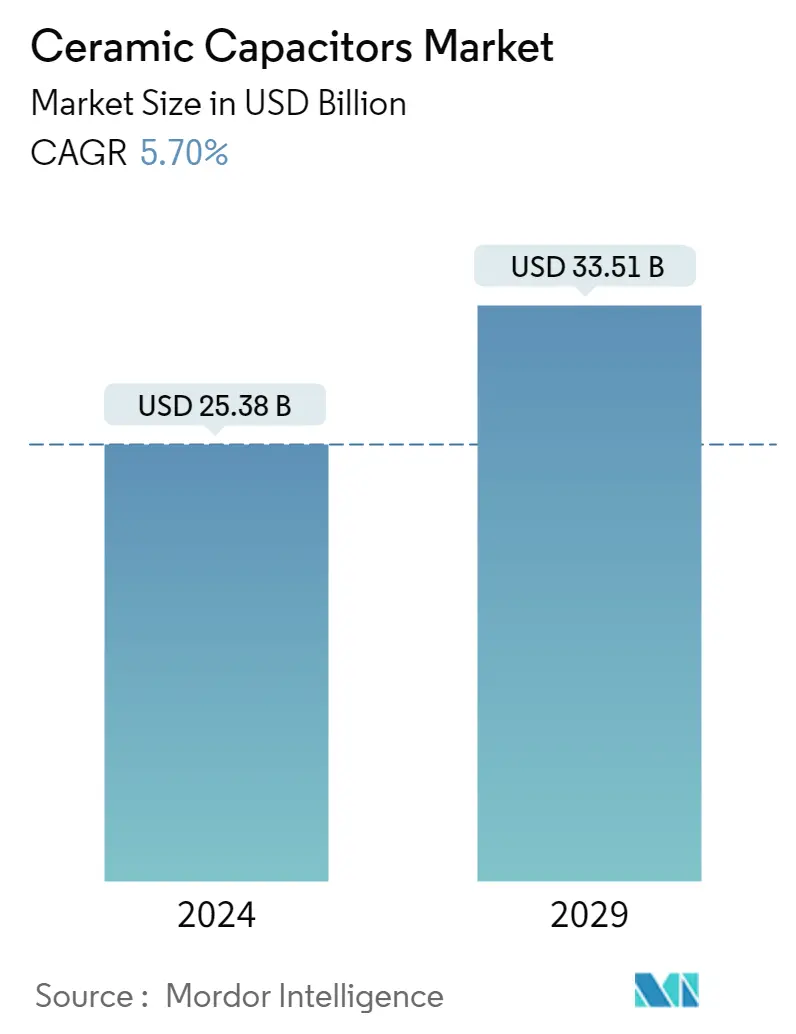
| Study Period | 2019 - 2029 |
| Market Size (2024) | USD 25.38 Billion |
| Market Size (2029) | USD 33.51 Billion |
| CAGR (2024 - 2029) | 5.70 % |
| Fastest Growing Market | Asia Pacific |
| Largest Market | Asia Pacific |
Major Players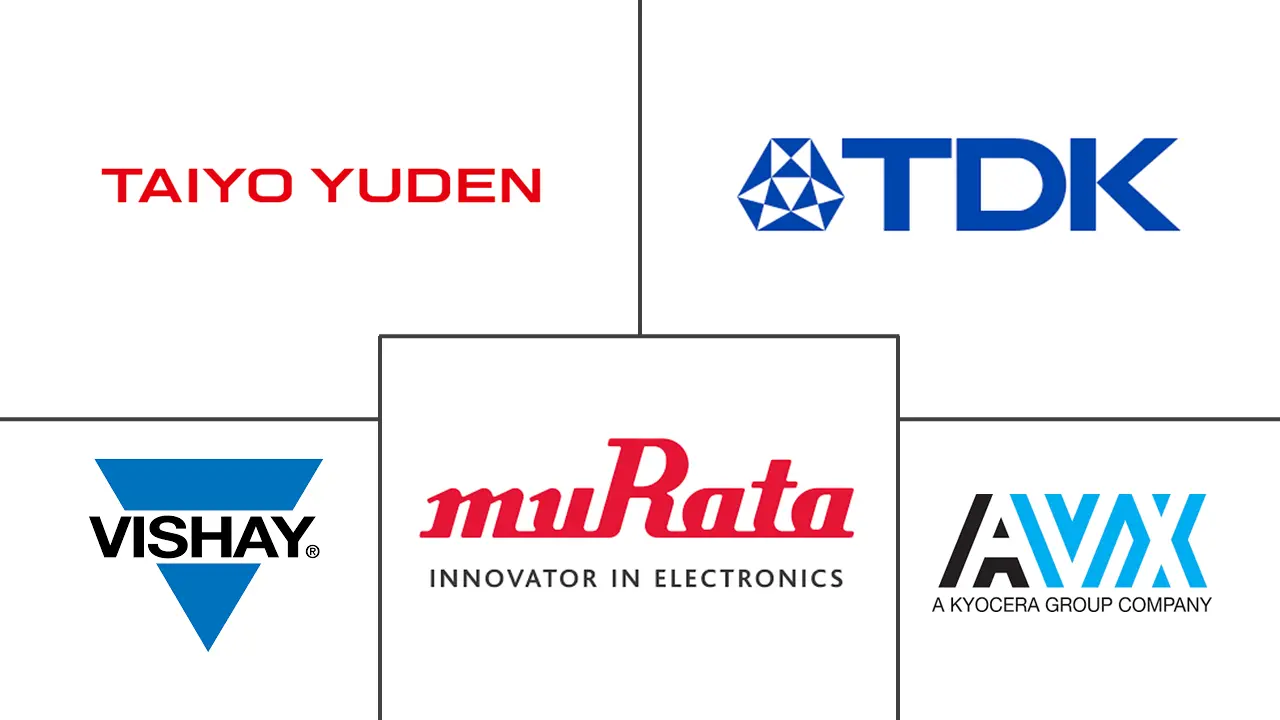
*Disclaimer: Major Players sorted in no particular order |
Ceramic Capacitors Market Analysis
The Ceramic Capacitors Market size is estimated at USD 25.38 billion in 2024, and is expected to reach USD 33.51 billion by 2029, growing at a CAGR of 5.70% during the forecast period (2024-2029).
Ceramic capacitors are one of the most commonly used in most electrical instruments, as they offer reliability and are cheaper to manufacture. These capacitors are used in multiple industries and primarily consist of ceramic or porcelain discs that exist in a non-polarized form. The ceramic material is also an excellent dielectric due to its poor conductivity and its efficient support of electrostatic fields.
- Ceramic capacitors are mostly available in three types. However, other styles are also available: leaded disc ceramic capacitors for through-hole mounting, resin-coated surface mount multilayer ceramic capacitors (MLCC), and special type microwave bare lead-less disc ceramic capacitors, which are primarily intended to sit in a slot on the PCBs.
- Among the applications, MLCCs are essential components of many electronic devices and are widely used in such devices as wearable devices and smartphones (approximately 900 to 1100 multilayer ceramic capacitors are installed in a smartphone).
- Also, there has been a shift in preference in electronics from consumer electronics to computing. The emergence of AI, IoT, cloud, and digitalization has led manufacturers to concentrate on this segment. These new technologies have a high profit margin compared to consumer goods, and the units needed are also fewer, making it viable for manufacturers to manage their production lines.
- The widespread adoption of 5G smartphones and their increasing functionality are stoking demand for further miniaturization and higher electronic circuitry density. For instance, a number of companies, including Qualcomm and MediaTek, are releasing chipsets that support 5G, and numerous smartphone manufacturers are using them. Previously, 5G support was confined to only flagship mobiles; now, mid-level smartphones also support 5G to introduce cheaper chipsets in the market. Such initiatives are increasing the need for ceramic capacitors.
- On the flip side, the production of ceramic capacitors presents several challenges. One major challenge is manufacturing high-capacitance multilayer ceramic capacitors (MLCCs), which involves stacking many single-layer capacitors into a single package. The manufacture of these capacitors is fraught with problems, including mechanical susceptibility, cracking during surface-mount soldering to a circuit board, and difficulty achieving high uniformity of capacitance across the layers. Another challenge is capacitance's temperature and frequency dependence, which can cause issues in high-performance applications.
- The COVID-19 pandemic impacted the ceramic capacitor market. The pandemic caused disruptions in the supply chain and manufacturing processes, leading to fluctuations in the demand and supply of ceramic capacitors.
- However, the market was anticipated to recover as the situation normalized with the ongoing vaccination drives and relaxed regulations. Meanwhile, ceramic capacitor components were expected to witness a growing demand from other industries due to an increasing demand for consumer electronics and mobile devices, such as laptops and computers, due to the work-from-home scenario across the world. Also, significant demand was witnessed from the increasing trend of online gaming during the pandemic, which subsequently increased the demand for gaming and home theater electronics.
Ceramic Capacitors Market Trends
Automotive Segment is Expected to Drive the Market's Growth
- Ceramic capacitors are usually employed in automotive applications due to their compact size, high reliability, and ability to withstand high temperatures and vibrations. They filter out high-frequency noise from power supplies in various automotive systems, such as engine control units, infotainment systems, and lighting systems. They are also employed in snubber circuits to suppress voltage spikes and ringing in switching circuits and in coupling circuits to pass high-frequency signals between circuits. Further, they are used in timing and oscillation circuits, such as in resonant circuits for sensors and actuators, as well as in clock generators for various automotive systems.
- The new automotive features and functionality due to autonomous vehicle technologies, vehicle-to-vehicle communications, advanced driver-assistance systems, and other safety and sensing systems, like backup cameras and lane-departure detectors, are driving the demand for electronic components in automotive applications. Passive components, like ceramic capacitors, are required to ensure stability and interference-free designs.
- According to the World Economic Forum, over 12 million fully autonomous cars are expected to be sold annually by 2035, covering 25% of the global automotive market. Further, the new law emphasizes that such cars "must continue to offer the same high levels of occupant protection as current passenger vehicles." As the Transportation Secretary said, Pete Buttigieg's new rule is essential to establishing robust safety standards for ADS-equipped vehicles. Such developments aid the growth of the studied market by propelling the proliferation of the connected car market in the region. This may create opportunities for local and international edge computing players to expand their market share.
- The shift towards sophisticated vehicles, such as self-driving vehicles, ADAS (Advanced Driver Assistance Systems), is driving the use of MLCCs per vehicle. Therefore, to cater to such a trend, manufacturers are involved in product innovation related to higher capacitance for ceramic capacitors. For instance, in December 2021, Murata announced the development of a GCM31CC71C226ME36 MLCC that features the highest capacitance of 22 µF for MLCCs and has a voltage rating of 16V. The application of this MLCC is streamlined for automotive and safety applications. In addition, the capacitors are designed with thin-layer sheet forming technology to achieve greater reliability and efficiency.
- Similarly, in February 2022, the company launched the NFM15HC435D0E3 MLCC, designed with three terminals to provide a capacitance of 4.3 µF. The capacitors are designed for automotive applications to attain results on noise removal and superior decoupling that are required for high-performance processors employed in advanced driver assistance systems and autonomous driving functions. This indicates the growing demand for ceramic capacitors in the automotive industry. However, with the impact of the constant COVID-19 pandemic, the supply chain is expected to be disrupted on a small scale.
- Moreover, the demand for MLCC in electric vehicles is also increasing, as most of the EVs use close to 10-15,000 MLCC due to increased features like driver assistance functions and fully autonomous systems. The sales of EVs increased in 2022, according to the IEA, and accounted for 1.02 million electric vehicles. Such instances indicate the growing demand for MLCC in the automotive sector. Further, the high adoption of EVs and the complete phase-out dates of ICE engines set by various governments will drive the growth of MLCC in the automotive sector.
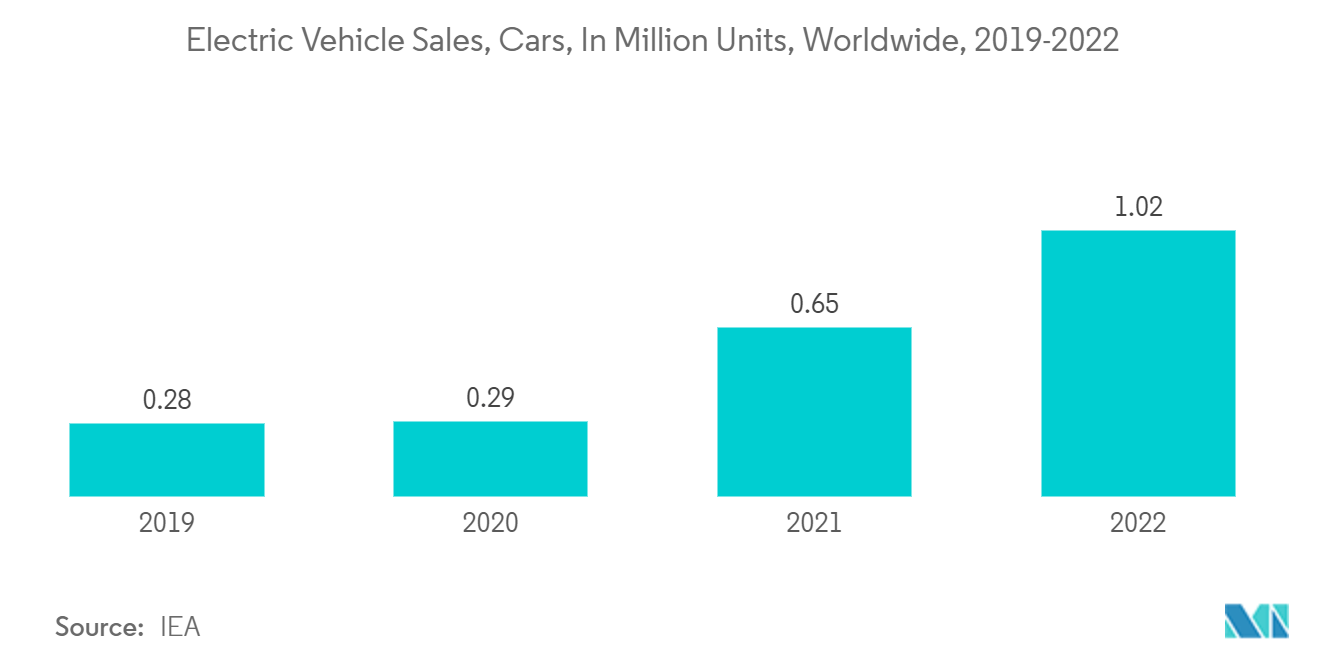
Asia-Pacific Region is Expected to Witness a High Market Growth
- The Asia-Pacific region is one of the most important markets for ceramic capacitors. The automotive industry is expanding in China, and the country plays an important role in the worldwide automotive market. The government sees its automotive industry, including the auto parts sector, as one of the country's primary industries. The government of China anticipates that China's automobile output is expected to reach 35 million units by 2025. This is expected to drive the capacitors' demand.
- The popularity of EVs is growing, and China is regarded as one of the dominant adopters of electric vehicles. The country's 13th Five-Year Plan promotes the development of green transportation solutions, such as hybrid and electric vehicles, for advancements in the country's transportation sector. China's electric cars were on track to reach the 20% nationwide penetration goal in 2022, well ahead of the Chinese government's 2025 forecast, due to new models by dozens of competitors attracting new buyers and encouraging owners to switch to electric vehicles.
- Further, the Japanese government aims to have all the new cars sold in Japan, whether electric or hybrid, by the year 2050. The country plans to also offer subsidies to accelerate the private sector's development of batteries and motors for electricity-powered vehicles. Japan is one of the countries that were early adopters of electric vehicles, with the launch of the Nissan LEAF and Mitsubishi i-MIEV more than a decade ago.
- Ceramic capacitors are commonly used in the telecommunications industry due to their high capacitance, high voltage tolerance, and low cost. They are employed in various applications, such as filtering, decoupling, and voltage regulation. In particular, multilayer ceramic capacitors (MLCCs) are popular in the telecommunications industry due to their compact size and high capacitance values. MLCCs are used in various applications, including smartphones, base stations, and other telecommunications equipment.
- Manufacturers in the Asia-Pacific region, such as Kyocera and KEMET, produce ceramic capacitors designed for telecommunications applications. The increasing telecom demand in the region is anticipated to boost the demand for ceramic capacitors in the region. For instance, according to China Telecom, in 2022, it generated revenue of approximately CNY 475 billion, a significant increase from CNY 440 billion in the previous year.
- China has been a significant contributor to the growth of the AGVs in the Asia-Pacific region. The growing demand for AGV products across industries, such as manufacturing, automotive, and e-commerce, among others, is boosting the market's growth positively. An AGV requires high power bursts for dumping or lifting, as well as continuous energy for traveling between stations. These bursts of power significantly reduce battery life, requiring manufacturers to replace batteries frequently. There is also the need to exchange batteries during working shifts. Unlike batteries, capacitors require little maintenance and can be charged in seconds using in-floor inductive charging, freeing manufacturers from constant battery swaps and replacements. The increasing factory automation in the Asia-Pacific region is anticipated to drive the demand for ceramic capacitors during the forecast period.
- Additionally, the players in the region are offering various products to cater to a wide range of customers' needs. For example, Murata Manufacturing Co., Ltd. offers various ceramic capacitors, including multilayer ceramic capacitors (MLCCs), high effective capacitance, and high ripple current chip MLCCs for automotive powertrains, and safety chip MLCCs for consumer electronics and industrial equipment. Murata's ceramic capacitors are renowned for their small size and large capacitance values. They have also developed and started mass production of the GCM033D70E105ME36, the world's first MLCC capacitance of 1 µF/25 V.
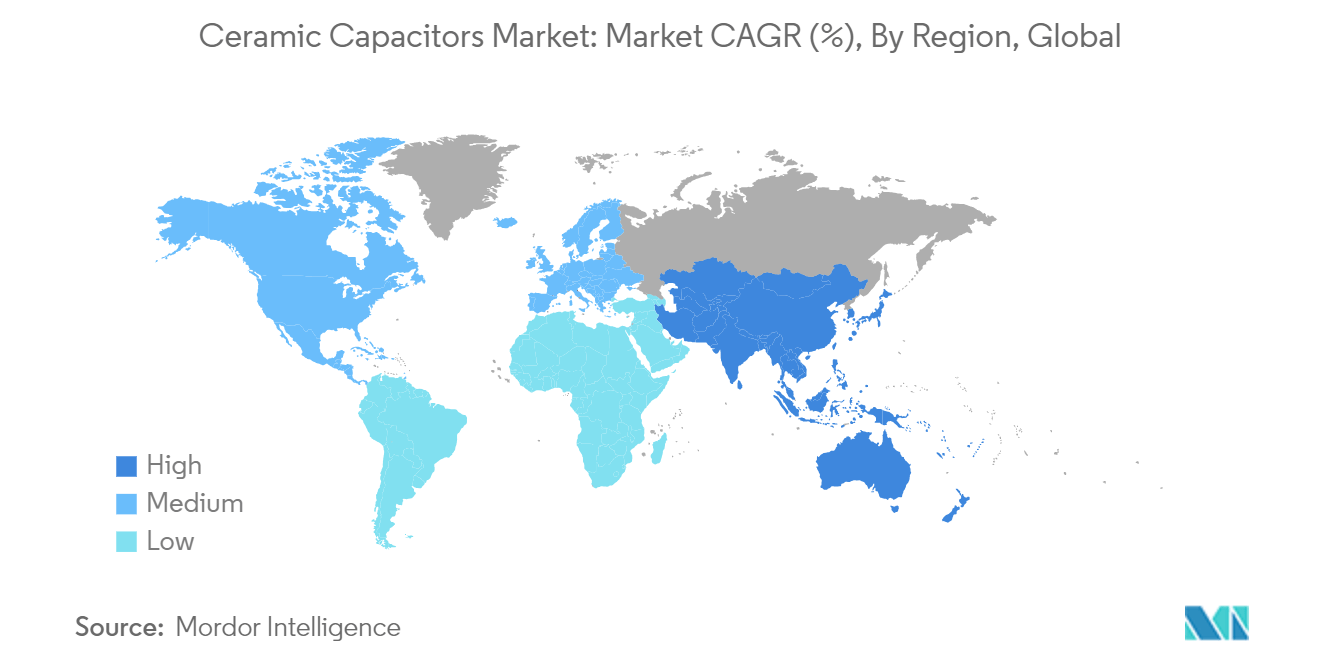
Ceramic Capacitors Industry Overview
The ceramic capacitor market is Semi-consolidated due to limited vendors in the global market. The key players are involved in various strategies, such as acquisitions and partnerships, to improve their market share and enhance their profitability in the market. Some of the leading players are there in the market are Murata Manufacturing Co., Ltd., TDK Corporation, Taiyo Yuden Co., Ltd., AVX Corporation, Vishay Intertechnology, Inc., and many others.
- November 2023: Kyocera AVX has introduced the KGK series of capacitors that comply with Class X1/Y2 standards and the KGH series of capacitors that comply with Class X2 standards. These capacitors, with a voltage rating of 250 VAC, are designed to meet the requirements set by EN 60384-14, IEC 60384-14, and UL 60384-14 standards. They offer surge and transient protection and EMI filtering, making them suitable for use in various consumer and industrial devices such as modems and fax machines.
- September 2023: TDK Corporation has introduced an enhanced version of its CN series of multilayer ceramic capacitors (MLCCs) that boasts an innovative and distinctive design. In contrast to conventional soft termination MLCCs, where the entire terminal electrodes are coated with resin layers, this new design incorporates resin layers only on one side that is mounted on a board. Moreover, TDK Corporation has also expanded its product range by introducing the CNA series (automotive grade) and CNC series (commercial grade) to cater to the growing demand for MLCCs with larger capacitances.
Ceramic Capacitors Market Leaders
-
Vishay Intertechnology, Inc.
-
TDK Corporation
-
Murata Manufacturing Co., Ltd.
-
Taiyo Yuden Co., Ltd.
-
AVX Corporation
*Disclaimer: Major Players sorted in no particular order
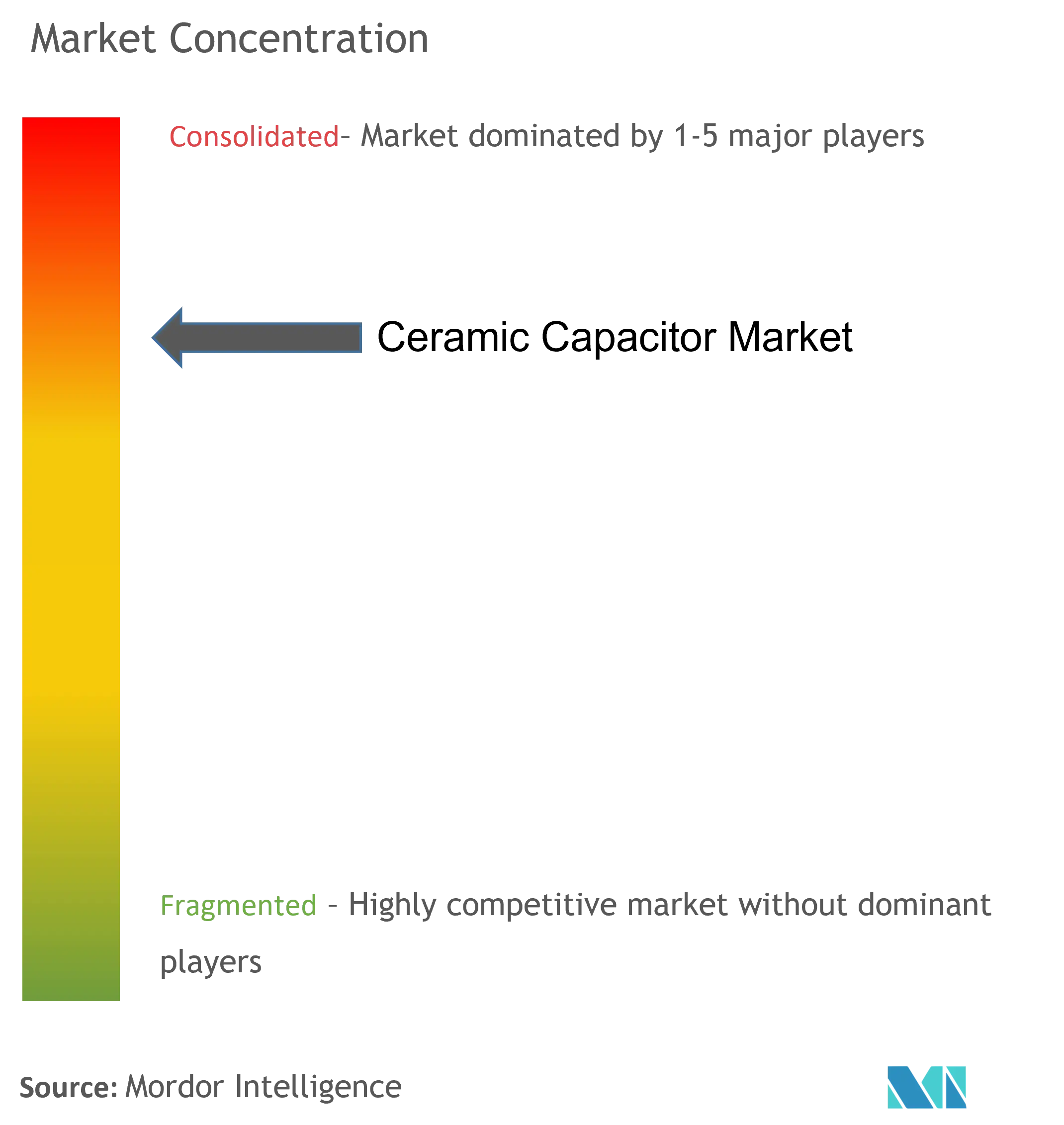
Ceramic Capacitors Market News
- April 2023: Kyocera Corporation announced the development of a novel capacitor (MLCC) with an EIA 0201 dimension (0.6 mm x 0.3 mm) and the industry's maximum capacitance of 10 microfarads. Kyocera's KGM03 series is claimed to be one of the most extensively utilized MLCCs in smartphones and wearable devices, measuring only 0.6 mm x 0.3 mm. The designers would be able to meet system requirements with fewer components and less space if an MLCC this compact had a higher capacitance.
- February 2023: Samsung Electro-Mechanics (SEMCO) announced that it was planning to increase manufacturing capacity for high-performance automotive multilayer ceramic capacitors (MLCCs), a new engine, in 2023 in order to close the market share gap with key competitors. SEMCO is projected to concentrate its investment in production bases such as Tianjin, China, as demand for critical IT goods such as smartphones decreased due to the recent economic slump. With its extensive experience in developing modern IT MLCCs, it intends to concentrate on producing extremely reliable automotive goods.
Ceramic Capacitors Market Report - Table of Contents
1. INTRODUCTION
- 1.1 Study Assumptions and Market Definition
- 1.2 Scope of the Study
2. RESEARCH METHODOLOGY
3. EXECUTIVE SUMMARY
4. MARKET INSIGHTS
- 4.1 Market Overview
-
4.2 Industry Attractiveness - Porter's Five Forces Analysis
- 4.2.1 Bargaining Power of Suppliers
- 4.2.2 Bargaining Power of Buyers
- 4.2.3 Threat of New Entrants
- 4.2.4 Threat of Substitutes
- 4.2.5 Intensity of Competitive Rivalry
- 4.3 Value Chain Analysis
- 4.4 Macro-economic Assessment Including Post-COVID-19 Analysis
5. MARKET DYNAMICS
-
5.1 Market Drivers
- 5.1.1 Growing Penetration of Digitalization and 5G technology
- 5.1.2 Adoption of Factory Automation and Robotics
-
5.2 Market Restraints
- 5.2.1 Requirement of Advanced Micro level Technical Competence for Developing Ceramic Capacitors
6. MARKET SEGMENTATION
-
6.1 By Type
- 6.1.1 MLCC
- 6.1.2 Ceramic Disc Capacitor
- 6.1.3 Feedthrough Ceramic Capacitor
- 6.1.4 Ceramic Power Capacitor
-
6.2 By End-User
- 6.2.1 Consumer Electronics
- 6.2.2 Automotive
- 6.2.3 Telecommunication
- 6.2.4 Industrial
- 6.2.5 Energy & Power
- 6.2.6 Other End-Users
-
6.3 By Geography
- 6.3.1 North America
- 6.3.2 Europe
- 6.3.3 Asia-Pacific
- 6.3.4 Latin America
- 6.3.5 Middle East and Africa
7. COMPETITIVE LANDSCAPE
-
7.1 Company Profiles
- 7.1.1 Murata Manufacturing Co., Ltd.
- 7.1.2 TDK Corporation
- 7.1.3 Taiyo Yuden Co., Ltd.
- 7.1.4 Vishay Intertechnology, Inc.
- 7.1.5 AVX Corporation
- 7.1.6 Johanson Dielectrics, Inc.
- 7.1.7 AFM Microelectronics
- 7.1.8 Kemet Corporation
- 7.1.9 Walsin Technology Corporation
- 7.1.10 TE Connectivity
- *List Not Exhaustive
8. INVESTMENT ANALYSIS
9. FUTURE OUTLOOK OF THE MARKET
** Subject To AvailablityCeramic Capacitors Industry Segmentation
Ceramic capacitors are made of ceramic material as dielectric. These capacitors comprise two or more layers of ceramic and a layer of metal acting as electrodes. The composition of the ceramic material determines its electrical behavior and, therefore, its applications. Layers of ceramic and a layer of metal act as electrodes. The composition of the ceramic material determines its electrical behavior and, therefore, its applications. Ceramics are inorganic, crystalline oxide, non-metallic nitride, or carbide compounds like silicon and carbon.
The ceramic capacitors market is segmented by type (MLCC, ceramic disc capacitor, feedthrough ceramic capacitor, ceramic power capacitor), end-user (consumer electronics, automotive, telecommunication, industrial, energy & power, and other end-users), and geography (North America, Europe, Asia-pacific, Latin America, and, Middle East and Africa). The market sizes and forecasts are provided in terms of value (USD) for all the above segments.
| By Type | MLCC |
| Ceramic Disc Capacitor | |
| Feedthrough Ceramic Capacitor | |
| Ceramic Power Capacitor | |
| By End-User | Consumer Electronics |
| Automotive | |
| Telecommunication | |
| Industrial | |
| Energy & Power | |
| Other End-Users | |
| By Geography | North America |
| Europe | |
| Asia-Pacific | |
| Latin America | |
| Middle East and Africa |
Ceramic Capacitors Market Research Faqs
How big is the Ceramic Capacitors Market?
The Ceramic Capacitors Market size is expected to reach USD 25.38 billion in 2024 and grow at a CAGR of 5.70% to reach USD 33.51 billion by 2029.
What is the current Ceramic Capacitors Market size?
In 2024, the Ceramic Capacitors Market size is expected to reach USD 25.38 billion.
Who are the key players in Ceramic Capacitors Market?
Vishay Intertechnology, Inc., TDK Corporation, Murata Manufacturing Co., Ltd., Taiyo Yuden Co., Ltd. and AVX Corporation are the major companies operating in the Ceramic Capacitors Market.
Which is the fastest growing region in Ceramic Capacitors Market?
Asia Pacific is estimated to grow at the highest CAGR over the forecast period (2024-2029).
Which region has the biggest share in Ceramic Capacitors Market?
In 2024, the Asia Pacific accounts for the largest market share in Ceramic Capacitors Market.
What years does this Ceramic Capacitors Market cover, and what was the market size in 2023?
In 2023, the Ceramic Capacitors Market size was estimated at USD 24.01 billion. The report covers the Ceramic Capacitors Market historical market size for years: 2019, 2020, 2021, 2022 and 2023. The report also forecasts the Ceramic Capacitors Market size for years: 2024, 2025, 2026, 2027, 2028 and 2029.
Ceramic Capacitors Industry Report
Statistics for the 2024 Ceramic Capacitors market share, size and revenue growth rate, created by Mordor Intelligence™ Industry Reports. Ceramic Capacitors analysis includes a market forecast outlook to for 2024 to 2029 and historical overview. Get a sample of this industry analysis as a free report PDF download.



